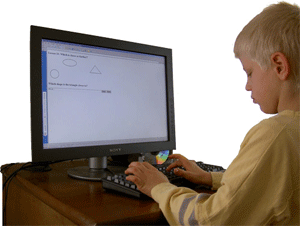The Theory & Teaching Strategy of the SentenceWeaver
Most autistic children have serious trouble mastering the grammar of their native languages. Recent research suggests that, absent co-morbid conditions like Specific Language Impairment and apraxia of speech, this language difficulty is not a distinct impairment, but rather a consequence of one of the core deficits of autism: a weakness in reciprocal interactions like Joint Attention and social referencing (see, for example, Paul Bloom's How Children Learn the Meanings of Words). Neurotypical children pick up language naturally from their social surroundings; autistic children may be just as capable of learning language, but must do so by other means. To the extent that individuals with autism don't fully attend to the language that surrounds them, they lack access to the kind of immersion necessary for linguistic mastery.
The same is true of children with hearing impairments, who are surrounded by a spoken language to which they lack full acoustic access, and yet are perfectly capable of learning language.
And the same is true of people learning English as a non-native language--ESL/ELL students--who may also lack access to a full immersion environment for learning English.
For anyone who lacks access to a full immersion environment, explicit language instruction is the next best thing.
For many components of language--particularly pronunciation, vocabulary and pragmatics--individuals with autism, in paticular, require intensive one-on-one therapy and/or explicit teaching in the natural environment. There is, however, one key component of language that can be taught separately, in conjunction with these other interventions, but in a setting that doesn't require the intensive manpower of most other therapies. The component in question is GRAMMAR, or, more precisely, the capacity to put words together into meaningful, grammatical sentences-- an essential component of language and thought. The setting is the simplified, predictable, distraction-free, and highly visual world of a specially-tailored computer software program.
Drawing on the ease with computers and relative strengths in visual processing and printed-word recognition that are typical of high functioning autistic and auditorially-impaired children, the SentenceWeaver teaches English grammar through text and pictures. It shows a picture, asks a question about the picture, and prompts the child to click in an answer, word by word. First the child simply copies the correct answer from a list of possible choices; after he successfully completes this part of the lesson, SentenceWeaver gives him the same group of exercises in an "open ended" format, with no answers to choose from. The child, therefore, must now internalize his learning. Once she successfully completes this section she receives similar exercises which haven't appeared in multiple choice format. Now he must generalize his learning.
In the latest SentenceWeaver upgrade, users can now speak in their answers rather than inputting them as text.
As the child progresses, he accumulates points that he can cash in, in the real world, for whatever reward he and his parents have agreed upon and typed in at the beginning of the session. Once the child reaches the requisite number of points, also typed in by her parents ahead of time, a congratulatory message about this reward appears on the screen. This gives the parents total control over their child's motivation, allowing them to pick rewards as powerful and idiosyncratic as they deem necessary, and to integrate them seamlessly into each SentenceWeaver session.


